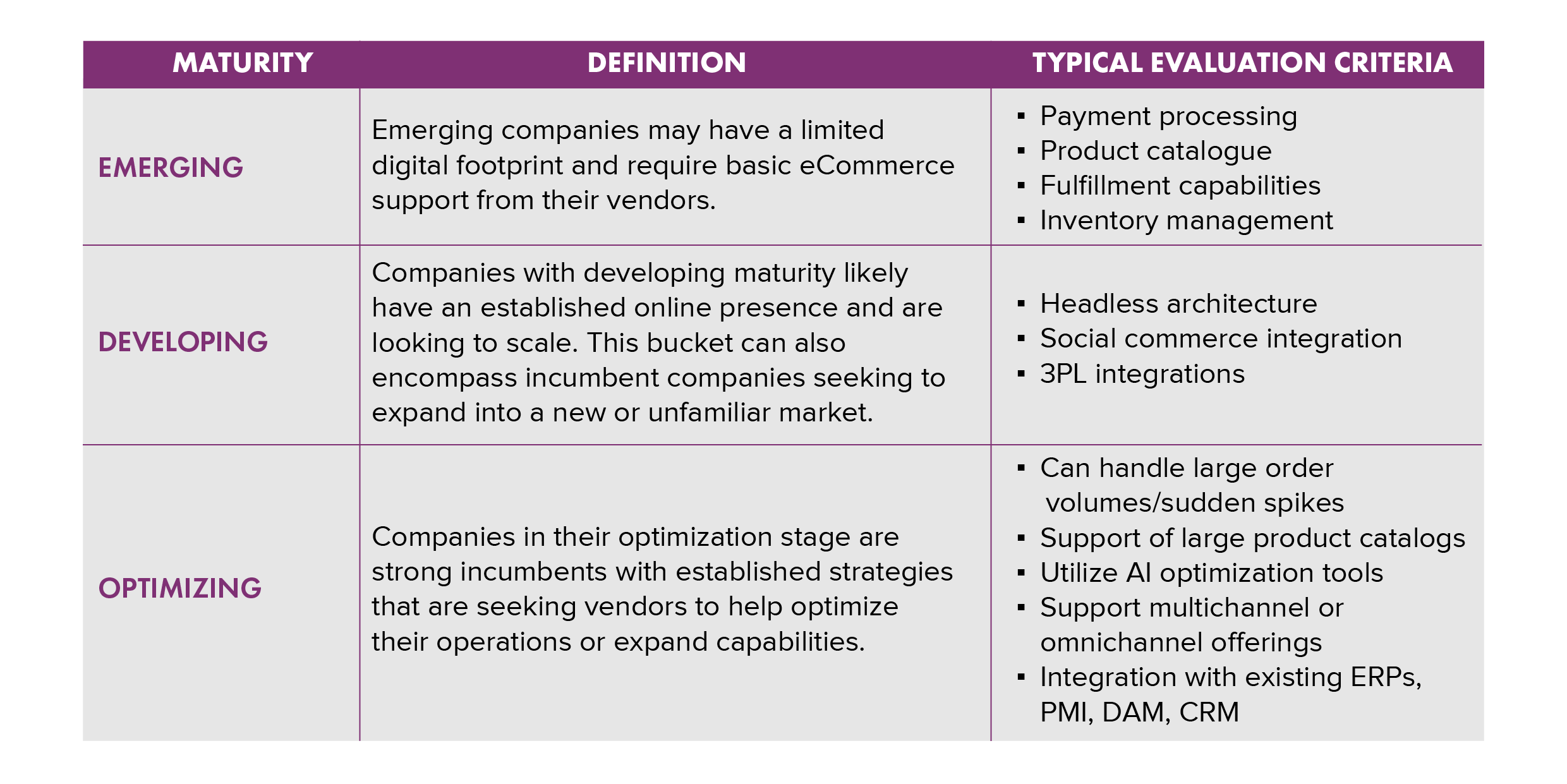Determining Your eCommerce Capabilities: 3 Considerations Before Selecting an eCommerce Vendor
Many of today’s retailers rely on third-party vendors to support their day-to-day eCommerce operations. Because of the instrumental role of these vendors, selecting the correct one to support your business’s needs and goals is critical. Before selecting an eCommerce vendor, it’s important to determine your eCommerce capabilities. To do this, Clarkston recommends understanding three key factors:
- Your company’s internal business needs in eCommerce,
- What services the eCommerce vendors offer, and
- How the eCommerce vendor offerings align with your business needs – both current and future.
While it may seem simple, following these steps is critical to ensuring you choose the right partner to meet your eCommerce needs. To help aid the process, we recommend evaluating your current state to determine whether your eCommerce capabilities are Emerging, Developing, or Optimizing. This categorization can be nuanced, and not all companies will fit neatly into each bucket. However, understanding where your company stands will help in understanding needs, and in turn, inform the vendor selection process.

Emerging
For emerging retailers new to eCommerce, or those trying to break into a new market, many vendors may to be able to meet a company’s needs. This could include fulfillment capabilities, inventory management, or social commerce integration. Looking for key differentiators among vendors’ offerings is the first step in finding the right vendor. In addition to feature differences, some vendors may provide expertise in a specialized area. In these cases, such vendors could offer tremendous value to support business goals such as growth or expansion into new markets. It’s important to keep in mind that vendors should not only meet your basic day-to-day needs but also align with short-term and long-term goals, where possible, to be able to scale as your company grows.
Developing
Companies that may already have experience in eCommerce as well as an established digital footprint will be looking beyond vendor features like payment processing as they look to scale. At this development stage, such companies should consider more flexible setups such as headless architecture. This set up allows companies to integrate with vendors while keeping their existing architecture. In turn, this improves agility, allowing companies to work across different regions with different front ends while keeping the back end the same. Such architecture also allows companies to effortlessly take payments across different currencies, without changes to the backend system. Coupling with a vendor to support the integration of headless commerce allows more flexibility for administrators. By choosing vendors with such an offering, companies can support their growth goals by ensuring the eCommerce vendor they select can scale and grow as they do.
Optimizing
Large enterprises demand the most feature-rich and robust systems to handle their daily functions at scale. Vendors catering to this eCommerce sector should include not only features like 3PL integrations and headless architecture, but also the ability to handle immense order volumes over short periods as well as tools like AI to enhance optimization efforts. Vendors catering to this company caliber need to have the capability to withstand high volumes of data and transactions, including sudden spikes in traffic and large product catalogs. The eCommerce vendor’s capabilities should also expand into multichannel or omnichannel offerings along with the offerings of deeper and more advanced analytics and integration with existing ERPs, PMI, DAM, and CRM. If it aligns with your goals, the architecture to support international expansion or development should be in place as well, including compliance with local laws and/ or regulations (GDPR) and multi-language and currency conversion support.
Selecting the Best Fit eCommerce Vendor
Whether you’re an enterprise-scale company looking to optimize with AI or a retailer getting your online store up and running, you will need vendors that can meet your unique requirements. After establishing what your specific business needs are, the eCommerce vendor selection process becomes an analysis of a vendor’s capabilities and tools as well as their ability to keep your business competitive in the ever-evolving eCommerce industry.
For more insight into the vendor selection process and information on how Clarkston can help your business choose the right partner, connect with our team today.
Subscribe to Clarkston's Insights
Contributions from Jacob Elson




